Death by stoning: Battered Syrian city offers a window into life under the thumb of Islamic State militants
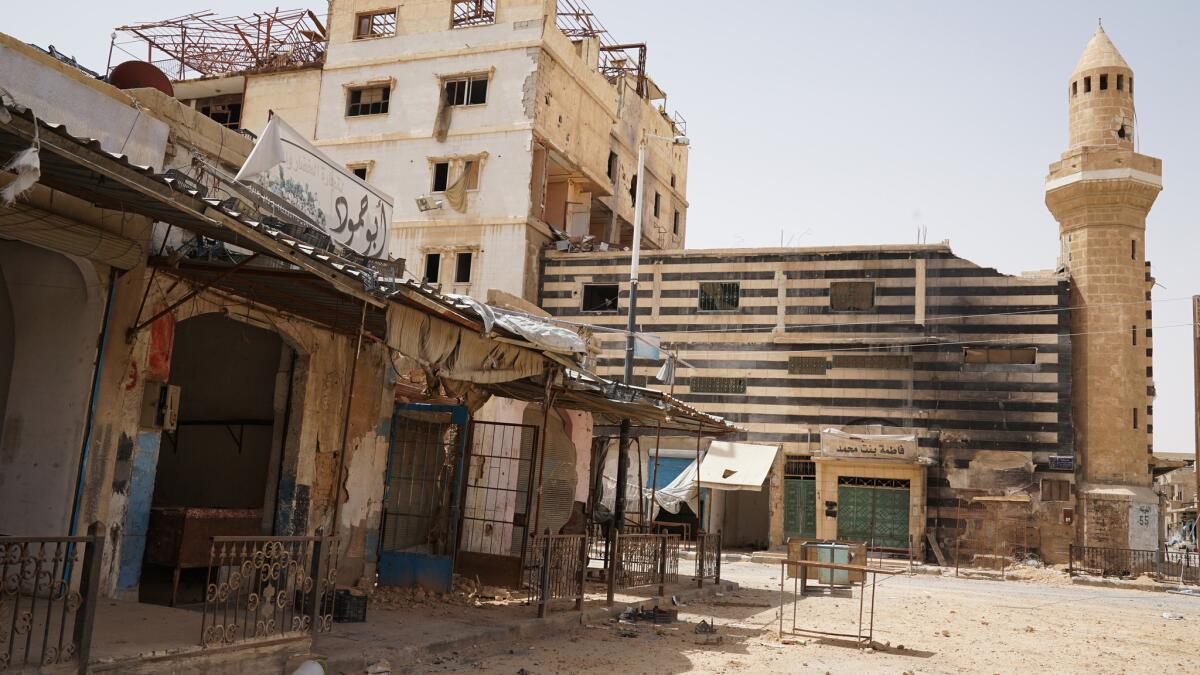
Reporting from Palmyra, Syria — Her name was Fatima Fakri Fathallah. How her case came before hard-core Sunni Islamist judges is not clear. Nor is it evident how she found herself accused of adultery.
But there is no mystery about the verdict: guilty as charged. The penalty: death by stoning.
A summary sheet of her chilling case was among the assorted documents scattered in an unmarked three-story building here that served as the headquarters of the Islamic sharia court whose jurisprudence ruled this city during its nearly yearlong occupation by Islamic State.
The Syrian military, backed by Russian forces, finally drove the militants out of Palmyra in March, ending the group’s grip on what was once a vibrant provincial center, best known as the entryway to the ruins of an ancient crossroads metropolis.
The militants fled so quickly the town remains semi-frozen in its most recent Islamic State incarnation, and objects left behind — from discarded armaments to rule books to Fakri’s guilty verdict — provide an uncommon window into daily life under the thumb of the jihadis.
The extremists’ systematic destruction of the iconic monuments at the Palmyra ruins, one of the planet’s archaeological jewels, sparked global condemnation. Less remarked upon was Islamic State’s regime of terror here in the town adjoining the ruins, which is known in Arabic as Tadmur.

The Syrian military, backed by Russian forces, finally drove the militants out of Palmyra in March, ending the group’s grip on what was once a vibrant provincial center that is now in ruins.
Viewing itself as a legitimate government, Islamic State set up a fledgling bureaucracy to deal with matters both mundane and consequential. The militants took their tasks seriously, and an abundance of paperwork displays an inflated sense of self-importance—and a clear conceit that they had settled in to stay. Islamic State administrators proved to be meddlesome and often homicidal micro-managers.
During the course of two occupations by the militants, Islamic State loyalists took the trouble to stencil new, multi-colored numbers on the town’s streets and buildings, an apparent effort to keep track of everyone living under the group’s maxims. The militants carefully noted each resident’s address, occupation and other details.
Palmyra, once a city of 70,000, is now mostly deserted and guarded by Syrian and Russian troops.
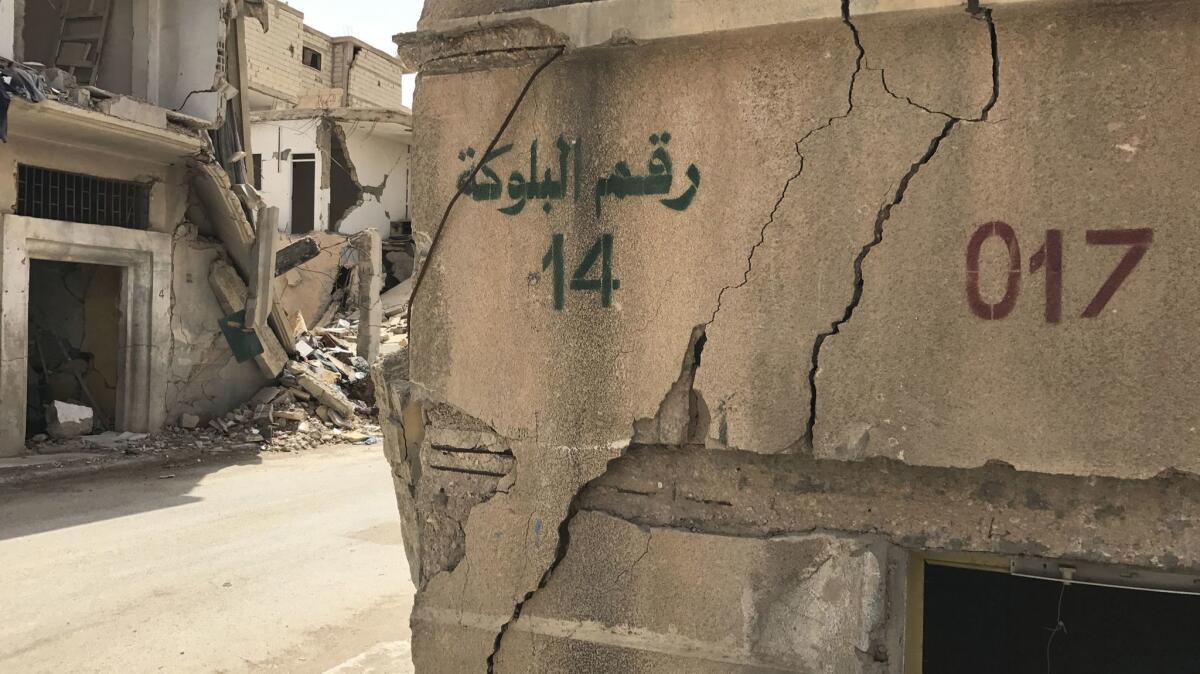
A visit here in 2014, before the first occupation, found a lively place where animated young men in Barcelona’s signature blue-and-garnet soccer jerseys gathered on a cool evening in a restaurant to watch a televised match. In a storefront down a side street, a shopkeeper in Arab dress furtively dispensed beer and spirits, normally proscribed pleasures in traditional Muslim communities. International tourists frequented restaurants, tea shops and Internet cafes, savoring Arab hospitality.
It was May 2015 when Islamic State first stormed Palmyra. The city was strategically significant: Aside from its historical import, it stands near natural gas fields and along key routes to Iraq, as well as to Damascus and other major population centers. Syrian and Russian forces evicted Islamic State in March 2016, but the militants recaptured the city in December — before finally being driven out in March.
The initial, rapid jihadi advance meant many residents were unable to flee, and townsfolk soon discovered the group had a hidden network of informers in Palmyra.
Triumphant Islamic State cadres soon went door to door, rounding up those regarded as collaborators with the “apostate” leadership in Damascus. Hundreds were reported executed in the first few days of occupation.
Reaching Palmyra now entails a jarring and surreal journey, beginning in the war-pulverized city of Homs and heading east through a paradoxically bucolic stretch of green hills and stands of olive and almond trees, along with grazing cows and sheep. Blankets of red poppies and yellow buttercups complete a tableau reminiscent of southern Italy.
Then the scene shifts to an apocalyptic desert-scape of downed power lines, charred armed vehicles and fortified Syrian checkpoints. Deep potholes indicate mortar strikes, or locations where Islamic State fighters planted roadside bombs as they withdrew.
On a recent day, military vehicles were the only traffic on the Palmyra highway. No villagers were seen for the final 60 miles or so. All roadside hamlets were abandoned. Many had been destroyed.
As Palmyra neared, a plume of dark smoke and a jet of intense flame could be seen rising from the Hayyan gas plant, blown up in January by retreating militants.
Both Syrian and Russian flags greet visitors at the last checkpoint before town. Inside Palmyra, reminders of Islamic State and its bureaucracy of oppression are near-ubiquitous.
Documents found in former militant-occupied buildings bear the group’s black emblem and the designation “Homs province.” The militants even produced handy scratchpads adorned with the Islamic State emblem and specifying “Homs branch.”
The Othman ibn Affan mosque, once a militant headquarters, is now a debris pile, its shattered green cupola lying like a discarded Easter egg atop a mound of crumbled masonry; loudspeakers that once broadcast the group’s edicts dangle from the smashed dome.
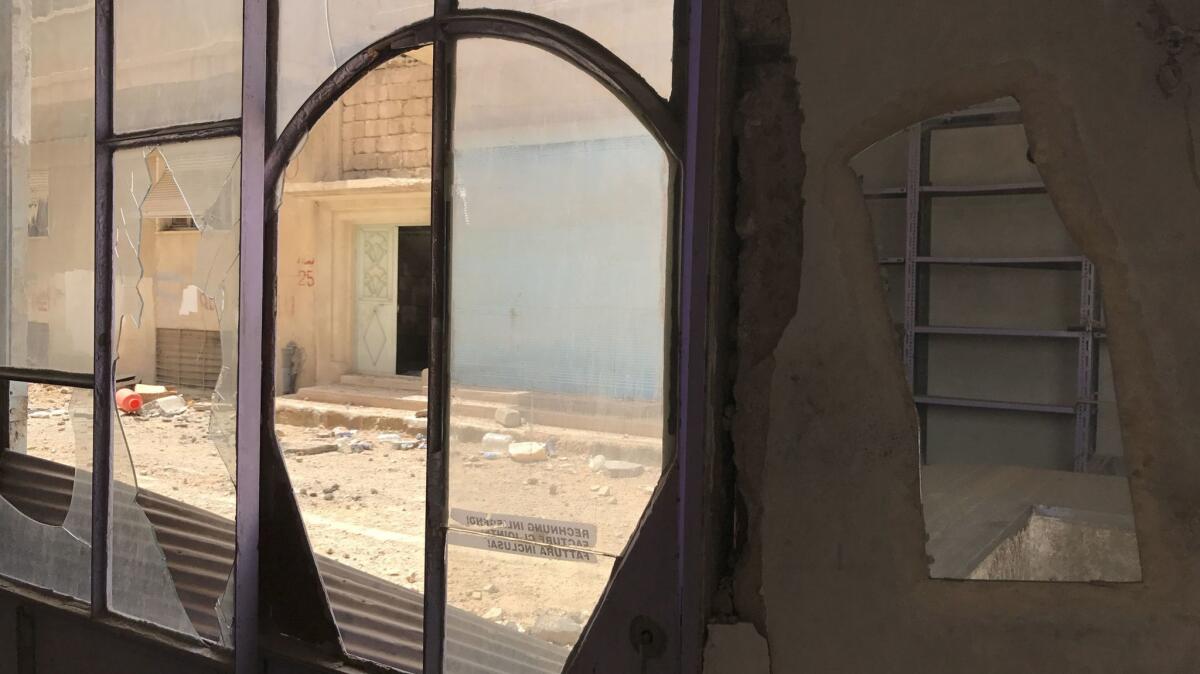
One former storefront — now bullet-pocked and looted — bears a text in ultra-formal Arabic outlining strictures placed on shop owners. The “pledge statement,” printed on Islamic State stationery and strung by a cord at the shop’s entrance, sketches a daunting set of requirements, from the “office of oversight and inspection” of the Hisbah, Islamic State’s notorious morality police.
Among other things, merchants had to pledge to close their doors during prayer times and commit to partake in group prayers; they had to vow not to sell cigarettes, and not to smoke or curse or “speak of immoral things.”
They also had to agree to take down images of people and remove all “immoral pictures” found on packaging. Furthermore, shopkeepers were to avoid “immoral” programming or images of “obscene women” on television.
Sellers could not allow women to lift their full face coverings and were obliged to refuse service to any woman wearing makeup. Unaccompanied women were banned from entering shops, though female customers could enter in groups or with male relatives.
In addition, merchants vowed to refrigerate meat — and not to sell meat from Turkey, for reasons that remain obscure. They vowed not to “cheat” Muslims and to pay their zakat, or tithe, to a designated Islamic State office. Fresh food was to be separated from chemical cleaning agents. All receipts were to be maintained, apparently for inspection and taxing by the new government.
Anyone in violation agreed to accept unspecified punishment meted out by the Hisbah.
The onetime shop with the frayed catalog of restrictions is situated in Nasser, or Victory Square, formerly known as Vegetable Square, after the plethora of vendors who once peddled fresh produce. During the militants’ reign, the square became notorious as one of Islamic State’s public execution hubs.
On May 23, 2015, seven men accused of being government collaborators, including a city councilman, were beheaded, their bodies left in the blazing sun. The councilman’s niece, 25, was also beheaded in a separate execution.
Here, as in other towns occupied by the Sunni extremists, bodies and severed heads were put on public exhibition and sometimes videotaped for grisly display on the Web.
Vegetable Square also features the remains of an unusual sniper position: a hole punched through a cardboard sheet with “Rehabilitation of Palmyra” written on it in English. A tarp from the United Nations’ refugee agency covers the sharpshooter ensemble.
The remains of parcels from international aid organizations litter the town.
Amid the papers scattered about bullet-pocked buildings is an oddity: a 1972 volume outlining the “economic and political” plans of the late North Korean leader Kim Il Sung, translated into Arabic, though his ultra-secular, communist dogma might seem an unlikely match for the religious extremists.
Down the street from Vegetable Square is a partially collapsed storefront that apparently served as an explosives factory. A pair of dust-covered gas masks, shards of munitions, gunpowder pellets, an ammo crate and other war materiel litter the floor. An acrid odor still permeates the place.
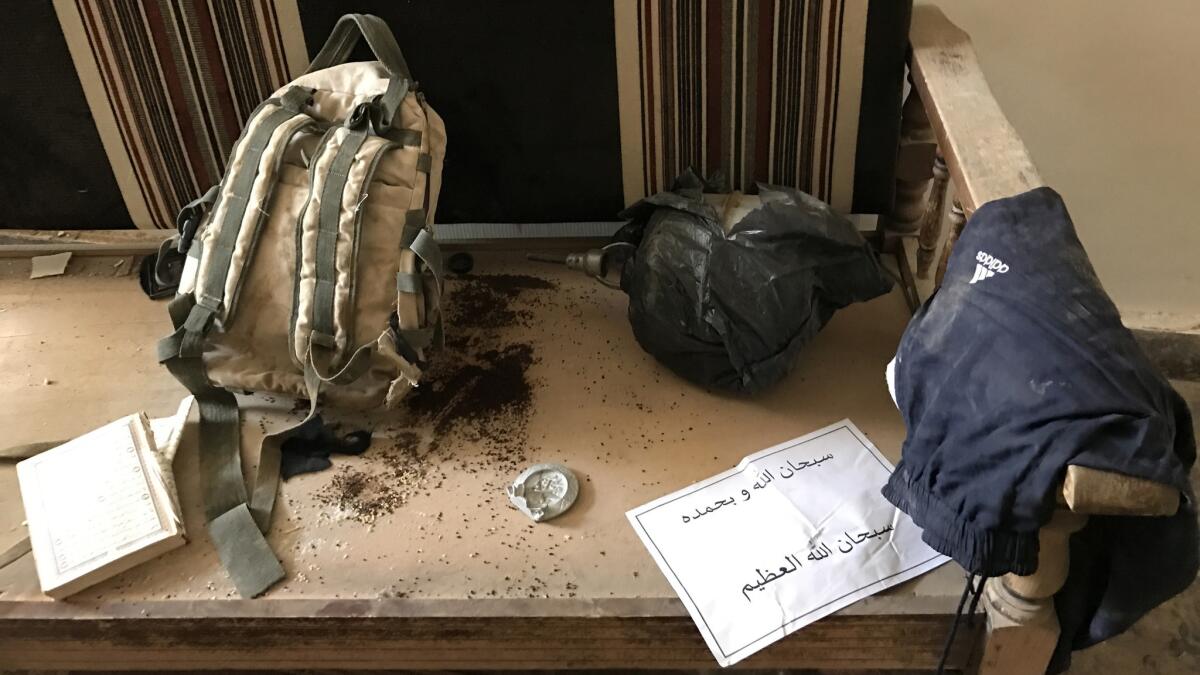
A backpack sits on a couch with a pair of Adidas sweats. A ledger on Islamic State stationery lists Toshiba, HP and other electronics gear, though it is unclear if the equipment was seized or shipped here.
Downstairs, the powerful stench of decomposition points to a clear conclusion: corpses, of militant fighters or civilians, entombed in the rubble. On the dirt road outside, a crater some 12 feet in diameter is evidence of a massive aerial strike that collapsed part of the bomb-making building and an adjacent structure.
Outside, the chirping of unseen birds interrupts the town’s eerie silence.
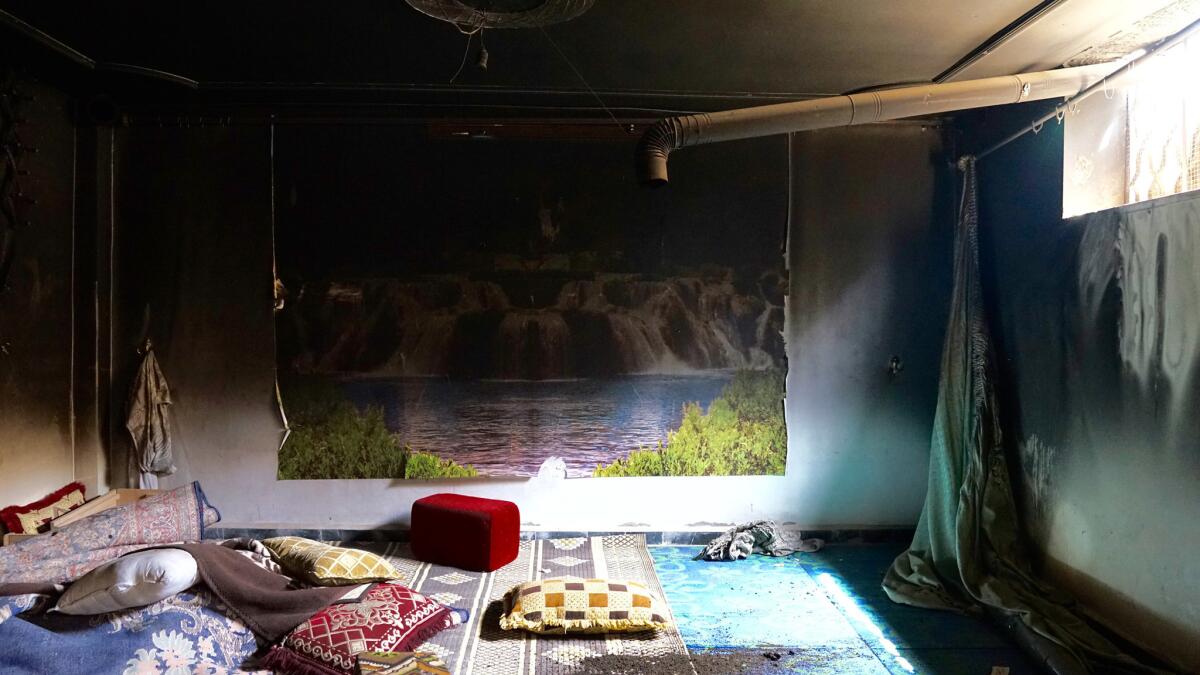
The sharia court lies just a few blocks from Vegetable Square. Formally, it was called the office of “grievances and the judiciary” in the “house of monotheism.” An odd sense of modest comfort lingers amid signs of war in the basement that served as a courtroom. Sandbags cover two windows. Once-plush cushions and an upturned blanket sit on a patterned carpet, now partially scorched.
One wall features an incongruous print of a waterfall flowing into a lake amid a verdant landscape, apparently a soothing backdrop for the spot where the chief judge presided. A clothes hook still holds a robe or jacket. Upturned cups and plates, along with a teapot and coffee server and what’s left of a kerosene heater, give the impression that court personnel evacuated with some haste as Syrian troops drew near. A well-thumbed Koran sits on the floor off to the side.

The case against Fatima Fakri Fahtallah is outlined on a single page found scattered amid more prosaic paperwork. It provides few details beyond her name, alleged crime and punishment.
The date is given in the Islamic calendar, corresponding to June 28, 2015, six weeks or so after Islamic State stormed the town. The document gives a judge’s name as Abu Banyan Homsi, which doesn’t correspond to a proper last name; it’s probably a pseudonym adopted for protection.
The ultimate fate of Fakri is unclear, lost in the fog of war. If the sentence was carried out, her remains probably rest in a common grave somewhere, along with those of so many former residents of this grievously wounded town.
twitter: @mcdneville
Special correspondents Liliana Nieto del Rio in Palmyra and Nabih Bulos in Beirut contributed to this report.
ALSO
She escaped Palmyra twice after Islamic State came to town. But her husband never made it out alive
Iranian President Rouhani wins reelection, beating hard-liner by a wide margin
More to Read
Sign up for Essential California
The most important California stories and recommendations in your inbox every morning.
You may occasionally receive promotional content from the Los Angeles Times.










